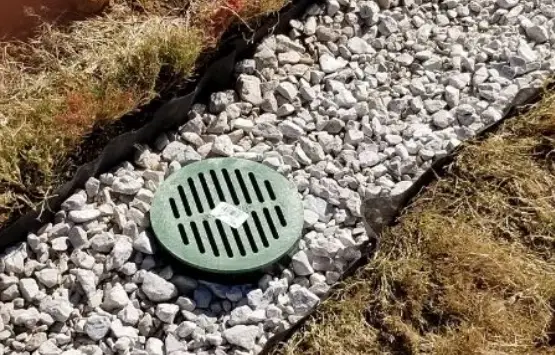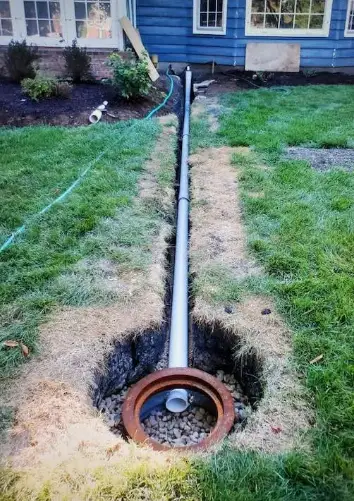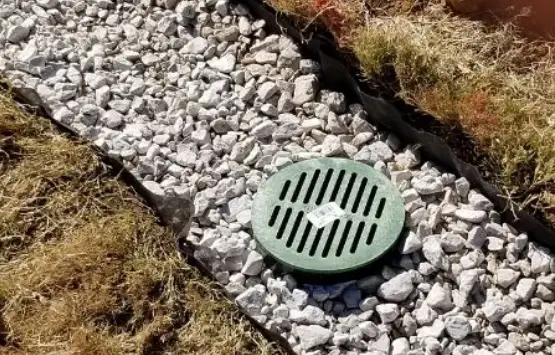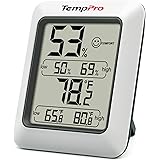Are you wondering what is the difference between a French Drain and a Dry Well? Well, if you are, you have come to the right place. French Drain and Dry Well are two of the most popular solutions when it comes to draining away rainwater.
In this article, we will delve deeper into the differences between the two drainage systems to help you select the best one for your situation.
A French Drain is a gravel-filled trench with a pipe at the bottom that collects water and moves it away from your home or property.
Dry Wells, on the other hand, are structures made for collecting and dispersing rainwater. Both can provide a way of managing water and keeping it away from your home or foundation.
However, there are several key differences between them that are worth noting.
Comparing French Drain and a Dry Well
| Specification | French Drain | Dry Well |
|---|---|---|
| Purpose | A trench that collects and disperses water that accumulates in the ground. | A filled and sealed container that collects water and disperses it through a series of channels slowly. |
| Type | Mostly dry well systems. | Smaller well systems and a network of surface drains. |
| Main Function | Diverts water away from structures, preventing flooding. | Collects and stores water in order to use it later (recharge groundwater). |
| Sub-Surface Drainage | N/A | May be used for sub-surface drainage. |
| Positioning | Drain should be placed below the seeping water line. | Dry wells should be located uphill from the structures they are protecting, in an area where the water drain can be easily channeled. |
| Installation | More difficult to install, especially when working around existing structures. | Easiest and most affordable to install. |
| Maintenance | Requires periodic inspection and cleaning. | No regular maintenance needed. |
| Lifespan | 25 to 50 years. | 15 to 25 years. |
| Coverage Area | Medium to large. | Small. |
| Climate Changes & Temperatures | Requires trenching if temperatures dip. | Not affected by climate changes. |
Both the French drain and the dry well are engineered water drainage systems designed to collect and disperse the water that accumulates in the soil. Though they’re similar in design, they function and behave differently.
It is important to understand the distinction between the two and to consider which type of drainage system will be most effective based on the situaton.
A French drain is a trench filled with gravel or rock, which functions as a pipe to collect and disperse water. It’s most often used as a means of collecting large areas of water that accumulates in the ground, typically by diverting surface runoff away from the structure its protecting.
It’s typically installed on a slope of land, below the seeping water line, and is generally more difficult for install.
Dry wells are containers filled with rocks and sealed at the top. They’re most often used to collect and store water, and disperse it through a series of channels, slowly releasing the water in order to recharge groundwater levels.
They’re usually much smaller than French drains and are easier to install, as they can be placed just about anywhere, as long as they’re installed uphill from the structures they’re protecting.
The French drain is a great solution for diverting water away from structures, while the dry well is the better option for collecting and storing water. It’s important to consider all the differences between the two systems before making a decision.
A detailed comparison table, like one provided above, can help to clearly demonstrate the technical differences between the two systems, as well as the situations that would make one option the ideal choice over the other.
French Drain vs Dry Well: What’s the Difference and How do They Work?
For those unfamiliar with the terms, trying to decide between a French drain and a dry well can seem like a daunting prospect. After all, these two names sound incredibly similar and yet they’re obviously different, so how can someone unfamiliar with these terms make a well-informed decision when it comes time to buy one or the other?
Thankfully, understanding the differences between a French drain and a dry well is actually quite easy once one has all the relevant information at her disposal.
What is a French Drain and How Does it Work?
A French drain is a type of drain often used as a perimeter or basement drain. Despite the name, this type of drain was actually developed in the United States by an American engineer by the name of Henry French.
This drain works by diverting water away from an area that’s prone to ground flooding or standing water buildup.
The primary materials used for a French drain are gravel and a perforated pipe. The perforated pipe is usually made out of PVC (polyvinyl chloride) and is designed to carry murky, gaseous water away from a particular area in your yard, basement, or elsewhere.
The pipe should always be installed in a sloping position, as it helps to encourage water flow. The gravel, meanwhile, keeps the perforated pipe in place by filling in some of the gaps and cracks atop the soil.
The basic idea behind a French drain is that it wants to move water quickly and efficiently, preferably downwards and away from the home. This is done by providing a pathway for the water to travel, so any water buildup will be able to get quickly transported away from an area with the help of gravity.
What is a Dry Well and How Does it Work?
A dry well is another type of drain, though its purpose couldn’t be more different than that of a French drain. Rather than removing water, a dry well intercepts the water as it passes by or through a particular area before sending it deep into the ground.
This type of drain is most often found in rocky, clay-filled areas or areas with higher ground.
A dry well consists of a large, cylindrical holding chamber that has been dug into the soil. This chamber is then filled with a drainage material, such as gravel, and a layer of concrete that’s given time to set.
Pipes from the area prone to water buildup or flooding can then be attached to the dry well, thus allowing them to intercept and collect any excess water, directing it into the well—hence the name.
Once the water reaches the holding chamber, it has two options: it can one, head down into deeper soil, or it can two, evaporate or be absorbed by the soil.
Regardless, the result is the same, as all excess water is quickly and efficiently removed from the targeted area.
The Pros and Cons of French Drains and Dry Wells
There are several key pros and cons for both of these draining types, some of which are outlined below:
French Drain Pros:
- Suitable for hilly or rocky terrain
- Can be used to reduce water buildup in an area, preventing floods
- Easy and relatively cheap to install
- Can be installed around the perimeter of an area, such as a basement or a yard
French Drain Cons:
- May require periodic cleaning and maintenance
- Can be difficult to move up or down slopes due to its large size
- Typically not the best option in areas with a lot of vegetation
Dry Well Pros:
- Can be used in areas with a lot of vegetation, rocks, and other obstructions
- Possibly cheaper than a French drain, depending on the area
- Keeps excess water out without having to expend too much energy in the process
Dry Well Cons:
- Could be detrimental to some plants if left unchecked
- Must be installed more or less perfectly, as even a slight miscalculation can impact performance
- Needs to be installed at the center of the dry area in order to function properly
Comparison of French Drain vs Dry Well

When it comes down to it, the main difference between a French drain and a dry well is that the former is a ready-made drainage solution for areas with standing water, while the latter is designed to divert water away from an area without having to constantly remove it.
In terms of value, both types of drain actually offer similar benefits, depending on the environment. A French drain, for example, may be more suitable for an area with a large amount of underground water whereas a dry well might work better in an area with a lot of rocks and vegetation.
Where installation is concerned, both types of drain require some form of digging. A French drain needs a footprint of roughly 15” wide by 15” long, whereas a dry well requires a deeper and wider footprint.
In terms of difficulty, however, installing either drain may depend on the condition of the soil and the environment and exceeds the scope of this article.
To French Drain or Dry Well? That is the Question
At the end of the day, the choice between a French drain and a dry well is both subjective and highly dependent on the environment.
Those who live in an area with a lot of vegetation may find a dry well to be more suitable, while those with a lot of underground water might find that a French drain is more effective.
It is worth noting, however, that deciding between the two may require a bit more effort than simply comparing their respective advantages and disadvantages. As such, it is generally recommended that one should consult a professional before making a decision.
In most cases, a professional will have the tools and the expertise to determine the type of drain that’s most suited to an individual’s particular circumstances.
As such, it is always preferable to have some form of expert guidance when it comes to this type of decision, as it allows one to make a well-considered decision without having to worry about damaging one’s home or property.
Key Differences Between French Drain and Dry Well

A French drain and a dry well are two methods used to manage surface runoff and groundwater, which can affect landscapes and buildings. Both methods are designed to remove excess water away from the ground, but how they operate and the benefits they offer can vary.
This article will explain the key differences between French drain and dry well, their installation requirements, as well as their effectiveness.
Installation and Structures
The most obvious difference between French drains and dry wells is the way they are installed. French drains have visible trenches that run due to gravity, whereas dry wells are buried in the ground and receive water from a pipe. A French drain consists of a perforated pipe surrounded by rocks, gravel and/or soil of various sizes.
This creates a pathway for surface water to flow away from the affected area. A dry well is a pit, approximately 3 to 6 feet deep and filled with rocks or other detritus. The well collects surface runoff then drains down to the water table, recharging groundwater levels.
Costs
When considering costs, both options can be expensive depending on the size of the job. French drains typically require more material (gravel and stone) and specialized contractors. Labor outlay is higher with a French drain as well because right materials and procedures must be followed to ensure a successful installation.
On the other hand, dry wells are easier to install with less materials, making them a cheaper option.
Maintenance
French drains require little to no maintenance upon installation. The pipes are self-cleaning and can last for years without any maintenance.
Dry wells on the other hand, require a certain level of maintenance, especially if they become clogged with debris. Regularly checking the well for clogs and flushing it out with water can help keep the well-functioning properly.
Effectiveness
French drains are the preferred choice for most water management projects because they are more effective at removing excess water from the site. The open trench allows water to move quickly through the pipe and away from the affected area.
In comparison, dry wells are less efficient because the water must pass through the detritus before it can be absorbed into the ground.
Placement
The placement of the drain or well is also another factor to consider when choosing between the two methods. French drains are ideal for areas that are not prone to flooding or where water moves downhill.
Dry wells are best suited for areas where flooding is frequent and where water can move through the well before draining into the ground.
There are many key differences between French drain and dry well that should be taken into consideration when determining the best method of water management for a particular site. French drains are more effective at managing surface runoff and can be ideal for areas where landscaping or flooding is not an issue.
Dry wells are cheaper in the long-term and better suited for sites that tend to flood regularly. Ultimately, both have their advantages and disadvantages, and choosing the right method for your project will ultimately depend on the site’s specific needs.
FAQs About French Drain and Dry Well
A French drain is an exterior drainage system, typically embedded in a trench dug along the perimeter of a property. The trench will be lined with gravel and include a perforated pipe or drain tile that carries water away from the foundation and redirects it to another location on the property, such as a catch basin.
A dry well is a prefabricated drainage system that is installed in the ground and collects and disperses water away from the property. It is composed of two components, an inlet pipe and a chamber with an open bottom which allows the water to slowly seep into the ground around the well.
A French drain works by capturing runoff water from the property’s foundation and redirecting it away from the building. The excess water is routed through a perforated pipe or drain tile placed in a gravel-filled trench. The pipe then carries the water away from the building and to a predetermined location where it can safely disperse.
A dry well system works by collecting and storing excess water and slowly releasing it back into the ground. The system consists of an inlet pipe which captures the water and a chamber with an open bottom which allows it to seep into the ground.
The primary advantage of a French drain is that it prevents water from accumulating near the foundation of a building which can cause costly water damage. Additionally, a French drain is an effective means for controlling surface water runoff, helping to reduce flooding in the surrounding area.
A dry well is an efficient and cost-effective way to collect and store excess water and slowly disperse it back into the ground. It is also an effective solution for water runoff control, as it helps to reduce flooding in the surrounding area.
A French drain typically lasts anywhere from 15-20 years, depending on the soil type and climate. If the soil surrounding the trench is prone to movement, due to freezing and thawing, erosion, or other factors, the drain may need to be replaced sooner.
A dry well typically lasts up to 20 years if properly maintained. If the soil is prone to movement, due to freezing and thawing, erosion, or other factors, the system may need to be replaced sooner. It is important to regularly inspect the system and make any necessary repairs to ensure it is functioning properly.
The cost of a French drain system varies depending on the size and complexity of the project. Generally, installation costs range from $5 to $25 per linear foot. Materials such as gravel and pipes can also increase the total cost.
The cost of a dry well system varies depending on the size and complexity of the project. Generally, installation costs range from $500 to $1,500. Materials such as gravel and pipes can also increase the total cost.
Wrapping Things Up
When it comes to finding the perfect solution for water drainage from your property, the choice between a french drain and a dry well is all about understanding the landscape and the water flow patterns. French drains are excellent for helping to redirect subterranean water, while dry wells are great for efficiently managing runoff water and redirecting it away from impervious surfaces and your home.
Ultimately, both techniques can be valuable tools for keeping your property and your home safe from flood damage, but the decision of which one to choose should be based on where you live and the unique needs of your property.
Auto Amazon Links: No products found.
Perfect Plants Christmas Tree Saver 8oz. | Easy Use Xmas Tree Preserver Food | Have Healthy Green Christmas Trees All Holiday Season
$13.99 (as of January 10, 2026 17:18 GMT +00:00 - More info- Product prices and availability are accurate as of the date/time indicated and are subject to change. Any price and availability information displayed on [relevant Amazon Site(s), as applicable] at the time of purchase will apply to the purchase of this product.
Wilt-Pruf® Christmas Tree/Cutting Preserver Spray |Preserves Christmas Trees, Wreaths, Garlands, Cuttings and Carved Pumpkins | Reduces Needle Drop | Keeps Cut Trees Fresh Longer | Natural (32 oz)
$21.99 (as of January 10, 2026 17:18 GMT +00:00 - More info- Product prices and availability are accurate as of the date/time indicated and are subject to change. Any price and availability information displayed on [relevant Amazon Site(s), as applicable] at the time of purchase will apply to the purchase of this product.
Rocky Mountain Goods Christmas Tree Food - 8 oz Tree Preservative - Reduce Needle Drop - Greener Scent - Fir, Pine, Spruce Trees - Extend Tree Life
$9.95 (as of January 10, 2026 17:18 GMT +00:00 - More info- Product prices and availability are accurate as of the date/time indicated and are subject to change. Any price and availability information displayed on [relevant Amazon Site(s), as applicable] at the time of purchase will apply to the purchase of this product.
HoHoHoH2o Automatic Christmas Tree Watering System Device, Santa’s Tree Helper Keeps Your Christmas Tree Healthy and Fresh, Refillable 2.5 gallons Capacity Box - Silver/Festive
$84.95 (as of January 10, 2026 17:18 GMT +00:00 - More info- Product prices and availability are accurate as of the date/time indicated and are subject to change. Any price and availability information displayed on [relevant Amazon Site(s), as applicable] at the time of purchase will apply to the purchase of this product.
FirEver Pure Christmas Tree Food | Preserver Additive & Season Extender for Live Xmas Trees | Keep It Green, Reduce Needle-Drop | Miracle Freshness (8 oz)
$16.66 (as of January 10, 2026 17:18 GMT +00:00 - More info- Product prices and availability are accurate as of the date/time indicated and are subject to change. Any price and availability information displayed on [relevant Amazon Site(s), as applicable] at the time of purchase will apply to the purchase of this product.
Zevo Flying Insect Trap Official Refill Cartridges - Fits Both Zevo Trap & MAX Indoor Fly Trap - Authentic Trap+Lock Technology to Catch Gnats, House & Fruit Flys (4 Official Refill Cartridges)
$14.97 (as of January 11, 2026 21:56 GMT +00:00 - More info- Product prices and availability are accurate as of the date/time indicated and are subject to change. Any price and availability information displayed on [relevant Amazon Site(s), as applicable] at the time of purchase will apply to the purchase of this product.
TERRO Ant Killer Bait Stations T300B - Liquid Bait to Eliminate Ants - Bait System - 12 Count Stations for Effective Indoor Ant Control
$11.25 (as of January 11, 2026 21:56 GMT +00:00 - More info- Product prices and availability are accurate as of the date/time indicated and are subject to change. Any price and availability information displayed on [relevant Amazon Site(s), as applicable] at the time of purchase will apply to the purchase of this product.
OLANLY Dog Door Mat for Muddy Paws 30x20, Absorbs Moisture and Dirt, Absorbent Non-Slip Washable Doormat, Quick Dry Chenille Mud Mat for Dogs, Entry Indoor Entryway Carpet for Inside Floor, Grey
$9.99 (as of January 11, 2026 21:56 GMT +00:00 - More info- Product prices and availability are accurate as of the date/time indicated and are subject to change. Any price and availability information displayed on [relevant Amazon Site(s), as applicable] at the time of purchase will apply to the purchase of this product.
Advion Cockroach Gel Bait, 4 Tubes x 30-Grams, 1 Plunger and 2 Tips, German Roach Insect Pest Control, Indoor and Outdoor Use, Roach Killer Gel for American, German and Other Major Cockroach Species
$25.81 (as of January 11, 2026 21:56 GMT +00:00 - More info- Product prices and availability are accurate as of the date/time indicated and are subject to change. Any price and availability information displayed on [relevant Amazon Site(s), as applicable] at the time of purchase will apply to the purchase of this product.
ThermoPro TP50 Digital Hygrometer Indoor Thermometer Room Thermometer and Humidity Gauge with Temperature Humidity Monitor
$9.99 (as of January 11, 2026 21:56 GMT +00:00 - More info- Product prices and availability are accurate as of the date/time indicated and are subject to change. Any price and availability information displayed on [relevant Amazon Site(s), as applicable] at the time of purchase will apply to the purchase of this product.











